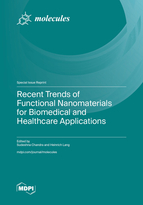Recent Trends of Functional Nanomaterials for Biomedical and Healthcare Applications
A special issue of Molecules (ISSN 1420-3049). This special issue belongs to the section "Inorganic Chemistry".
Deadline for manuscript submissions: closed (30 September 2023) | Viewed by 27544
Special Issue Editors
Interests: metal/metal oxide nanomaterials; hybrid metal sulfides nanomaterials; biosensors; energy devices; characterization of nanomaterials; electrochemistry
Special Issues, Collections and Topics in MDPI journals
Interests: organometallics; coordination chemistry; homogeneous catalysis; nanomaterials; electrochemistry
Special Issues, Collections and Topics in MDPI journals
Special Issue Information
Dear Colleagues,
Recent research developments in nanoscience and nanotechnology have seen plenty of nanomaterials for biomedical and healthcare applications. Several nanomaterials-based products and processes have been developed such as artificial organs and tissue engineered products, biomedical imaging and diagnostic devices, electronic and monitoring devices, therapeutic materials, biochip technology, gene sequencing, enzyme engineering, and so forth. Several types of nanomaterials including magnetic nanomaterials, carbon-based nanomaterials, metal/metal oxides/sulfides, and semiconductors-based nanomaterials are extensively used for drug/gene carriers; cell imaging and tracking; therapeutic modalities such as chemotherapy, hyperthermia, magnetic hyperthermia; contrast enhancers in imaging, etc. Unique physico-chemical properties of the nanomaterials, which are governed by shape, size, and chemical composition of the nanomaterials, are fundamental to these applications. For use in biomedicine, nanomaterials must fulfill certain criteria such as minimum toxicity, must be stable in physiological conditions, and must prevent non-specific interactions. Precise control over synthesis, surface functionalization and stability are key to successful implementation of nanomaterials in biomedicine. It is also important to understand the complex spatiotemporal interplay of nanomaterials with biomolecules at cellular levels and signaling pathways.
With respect to healthcare, development of wearable nanomaterial-based devices has gained tremendous attention in recent years. Particularly, 1D nanomaterials are widely used in bioelectronics for monitoring of electrophysiological signals. The growing need of devices with accurate and advanced functions have propelled the transformation of wearable devices to implantable devices. However, biocompatibility of such materials is also an important aspect as cells/organisms are exposed to both concentration and composition of nanomaterials. Therefore, long term biocompatibility studies are required for safe use of nanomaterial based implanted/wearable bioelectronic devices.
The aim of the Special Issue on “Recent Trends of Functional Nanomaterials for Biomedical and Healthcare Applications” is to invite the submission of original research, short communications, and review articles focusing on advanced nanomaterials to achieve better biomedical and healthcare application. This Special Issue will provide comprehensive information on advanced technologies and approaches for fabricating novel nanomaterials suited for biomedical and healthcare applications. The topics in the Special Issue can benefit advanced students, researchers, materials chemists, polymer scientists, biomedical engineers, and industry experts in developing smart and intelligent nanomaterials for future biomedical applications and healthcare devices.
We look forward to receiving outstanding contributions from esteemed researchers for this Special Issue of Molecules that focuses on the design, synthesis, characterization, applications, and potential challenges of advanced nanomaterials for implementation in biomedical and healthcare sectors.
Dr. Sudeshna Chandra
Prof. Dr. Heinrich Lang
Guest Editors
Manuscript Submission Information
Manuscripts should be submitted online at www.mdpi.com by registering and logging in to this website. Once you are registered, click here to go to the submission form. Manuscripts can be submitted until the deadline. All submissions that pass pre-check are peer-reviewed. Accepted papers will be published continuously in the journal (as soon as accepted) and will be listed together on the special issue website. Research articles, review articles as well as short communications are invited. For planned papers, a title and short abstract (about 100 words) can be sent to the Editorial Office for announcement on this website.
Submitted manuscripts should not have been published previously, nor be under consideration for publication elsewhere (except conference proceedings papers). All manuscripts are thoroughly refereed through a single-blind peer-review process. A guide for authors and other relevant information for submission of manuscripts is available on the Instructions for Authors page. Molecules is an international peer-reviewed open access semimonthly journal published by MDPI.
Please visit the Instructions for Authors page before submitting a manuscript. The Article Processing Charge (APC) for publication in this open access journal is 2700 CHF (Swiss Francs). Submitted papers should be well formatted and use good English. Authors may use MDPI's English editing service prior to publication or during author revisions.
Keywords
- nanomaterials
- implants and wearable devices
- drug delivery and therapeutic efficacy
- biosensors and bioelectronics
- biocompatible and toxicity
- bio-imaging and diagnostics
- healthcare devices
- theranostic platforms







